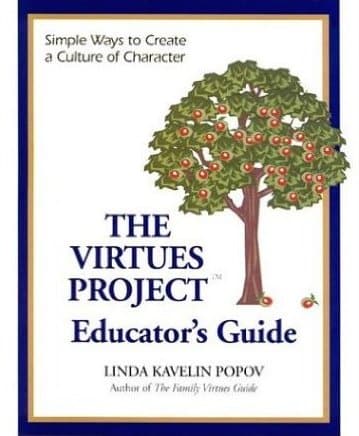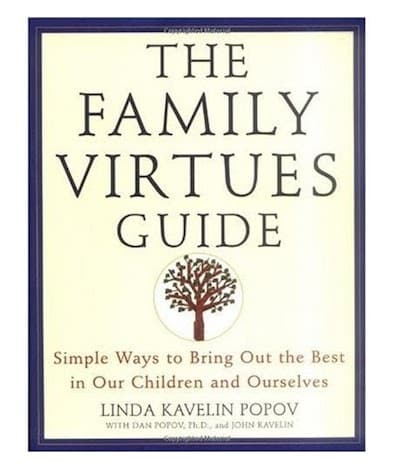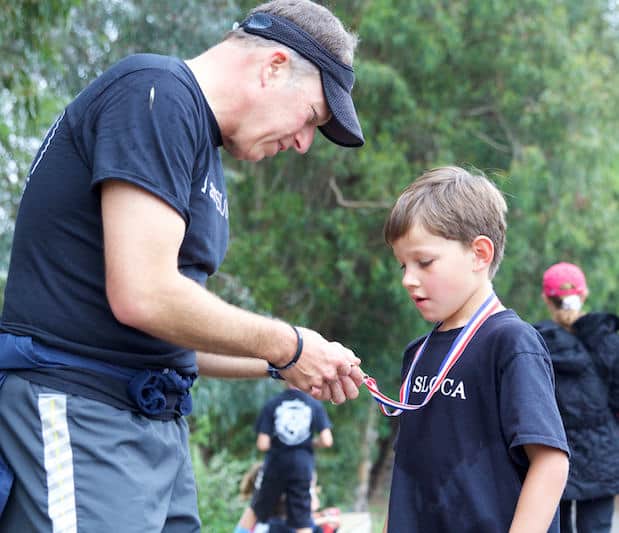
Classical Character
Mrs. Burns’ Book Review Blog
Last year Jenna Burns brought us Pedagogic Ponderings, a blog review of books on education. This year she brings us Classical Character, a book review blog examining the interplay of classical education and moral instruction. She is seeking answers to this question: How can we as parents, educators, and a school community shape moral children of uncompromising integrity? In her blog she gives us a snapshot of books on this subject with the intention of providing her readers with a manageable dose of practical inspiration. We hope her blog helps you better understand classical education, character building, and our school.
After teaching History and Language Arts at SLOCA UMS for five years, Jenna remains involved in SLOCA and is currently the WASC Accreditation Coordinator.
 This month I’m reviewing The Virtues Project, Educator’s Guide: Simple Ways to Create a Culture of Character by Linda Popov. I chose this book because: “The Virtues Project was honored by the United Nations during the International Year of the Family as a model global program for all cultures, and was featured on the Oprah Show as a method for teaching children to ‘do the right thing,’” (Amazon.com). I enjoyed reading the book and I have already experienced positive results from practicing some of the ideas in it. Read this month’s blog and embark on a walk-along, learn how to speak the language of virtues, and discover your leadership style.
This month I’m reviewing The Virtues Project, Educator’s Guide: Simple Ways to Create a Culture of Character by Linda Popov. I chose this book because: “The Virtues Project was honored by the United Nations during the International Year of the Family as a model global program for all cultures, and was featured on the Oprah Show as a method for teaching children to ‘do the right thing,’” (Amazon.com). I enjoyed reading the book and I have already experienced positive results from practicing some of the ideas in it. Read this month’s blog and embark on a walk-along, learn how to speak the language of virtues, and discover your leadership style.
The Virtues Project is geared towards educators looking for ways to nurture their students’ character. Resembling a textbook, the wide pages offer large subtitles, framed first hand accounts, and a lot of clip art.  The language is straightforward and the ideas, true to the title, are “simple” but wise. The Virtues Project has its own website (http://www.virtuesproject.com) and the author her own blog (http://gracefulendings.net/blog/). Popov also wrote The Family Virtues Guide, which may be a better fit for parents. However, I found The Virtues Project very practical and inspirational and I believe anyone reading it would come away with great ideas for the children in their lives.
The language is straightforward and the ideas, true to the title, are “simple” but wise. The Virtues Project has its own website (http://www.virtuesproject.com) and the author her own blog (http://gracefulendings.net/blog/). Popov also wrote The Family Virtues Guide, which may be a better fit for parents. However, I found The Virtues Project very practical and inspirational and I believe anyone reading it would come away with great ideas for the children in their lives.
The Virtues Project is basically divided into two parts. Part one outlines Popov’s five strategies for creating a culture of character, three of which I will share in a moment. Part two, a resource section, provides definitions, activities, questions, quotes, etcetera for 52 different virtues. We will take a look at one of these virtues a little later in the post.
Of the five strategies for character formation that Popov provides, let’s look at these three:
- Speak the Language of Virtues
- Set Clear Boundaries
- Offer the Art of Spiritual Companioning
 Speak the Language of Virtues
Speak the Language of Virtues
Language, Popov argues, “above all else awakens the character and shapes the self-esteem of our children,” (3). As adults, “We can choose to call children names which deepen the rut of their negative behavior patterns, using words like, ‘lazy’ . . . or we can call them by the names of their inner strengths, calling them to the virtues,” (3). The language we use when describing children is important because, “Children tend to act according to the way adults in their world see them,” (3).
Popov details specific ways to speak the language of virtues. First, when you see children practicing a virtue, praise them for it using specific language (5, 7). Instead of general praise like, “Good job,” use specific virtue acknowledgements: “Thank you for being patient to wait your turn.” Popov warns, “It is not helpful to label a child in any way, positive or negative,” (8). For example, “You’re so smart,” is not as helpful as, “You showed great diligence on your homework.”
Second, invite positive behavior by telling children what you want them to DO as opposed to what you DON’T want them to do (8). For example, “Don’t interrupt,” becomes, “Raise your hand,” which can even become the virtue-focused directive: “‘Please be considerate and raise your hand,’” (9).
Third, use the language of virtue to guide and correct behavior. In this way we can replace shaming language, “That behavior was unacceptable and rude,” with “an open invitation to do the right thing,” (10). For example, “You need to be respectful. What would be a kind way to say your opinion?” (11).
|
{photo source} |
Set Clear Boundaries
Popov describes different leadership styles: the permissive pal, side-stepper slider, dominant dictator, democratic diplomat, and the empowering educator (62). The permissive pal abdicates the responsibility of authority altogether, valuing the friendship above all else (62). The side stepper (this sounds most like my parenting), “starts off permissive but slides to dominance when things get out-of-hand,” (63). The dictator uses criticisms, sarcasm, and shaming in an attempt to achieve control and high standards (63). The diplomat leaves decisions to the students valuing equality over efficiency (64). The empowering educator is virtue-minded, has clear boundaries, and shows and expects respect at all times (64). Where do you fall? And what leadership style is most helpful in creating moral children?

Popov argues that authority should ideally be used, “to enable children to develop their own inner authority, a sense of personal responsibility and accountability,” (58). Empower not overpower. Be educative not punitive. Offer restitution not retribution, (60, 66). For what that really looks like, Popov offers ten guidelines for establishing clear boundaries, such as, “Give specific, relevant consequences,” and, “Be consistent,” (60, 71). The bottom line is, “Always use authority in service of learning,” (58).
When a child violates the clear boundaries you have set, Popov calls for restorative justice and restitution. This requires the adult to be the mentor and to ask questions like: “What happened? What virtue could have been practiced? And What amends can be made?” (66). The purpose of restorative justice is not to punish but to guide students to take responsibility, make restitution, and be reconciled (67).
 Offer the Art of Spiritual Companioning
Offer the Art of Spiritual Companioning
The third of Popov’s five strategies for building a culture of character is spiritual companioning, or to “walk along.” Popov explains: “Companioning is walking along with another, not pushing or pulling them, but being present to them and offering them clarifying questions which help them to find their own wisdom. It is called ‘spiritual’ because it goes beyond problem solving to the meaning, intent and virtues of a situation,” (109).
There are seven steps to spiritual companioning that you can call when a child needs discipline, is emotional or confused (110). The steps show how you as the adult can use attentive listening and mindful responses to support the child’s capacity to make moral choices (110). Four of those seven steps are:
- Offer receptive silence. Don’t interrupt. Be fully present and allow the child to speak fully, (113).
- Ask Cup-Emptying questions. In a non-judgemental way ask open-ended questions that allow the child to discover the true heart of the matter. “What is that like for you? What worries you? What is the hardest thing about this?” (114).
- Ask Virtues Reflection Questions. Begin to take the lead of the conversation now by asking virtue focused questions that help the child reflect and grow. “What would be a kind and assertive way to solve this? What does your integrity tell you to do? What is a fair way for you to make amends?” (115).
- Give Virtues Acknowledgement. Always end with a sincere acknowledgement of the child’s virtue: “I see your courage,” (115). I’ve tried this last idea in conversations with friends and have seen what a difference it makes. It feels good to have virtues praised.
Speak the Language of Virtues, Set Clear Boundaries, and Offer the Art of Spiritual Companioning are three of Popov’s strategies for building the character of a child. Did you notice that all three are about changing the adult’s behavior? Consider how much the adult’s character will stretch and grow as she practices these three strategies. Can I just pause here and sigh and say parenting is hard? I sometimes wish I could sit back and get comfortable (think: lazy) . . . and when it comes to my child’s character, shouldn’t my child be the one doing the work?
Of course this is fantasy not reality. A child’s character formation requires intentional effort and a consistent approach from the parent. The best way to influence my child’s behavior is by focusing on my own. I can begin by using virtue focused language, setting clear boundaries, and by practicing “walk-alongs.”
|
{photo by Wicker Paradise via flickr / CC BY 2.0} |
Now that we’ve looked at the first part of the book, let me show you a glimpse of the second part, the resource section outlining 52 virtues. As an example I’ll use SLOCA’s virtue of the month for March, courage. The following is paraphrasing and direct quotes from Popov’s character trait spotlight on courage (151-152).
What is courage? Personal bravery in the face of fear. Doing what needs to be done even when it is scary or you feel like giving up. Courage is admitting your mistakes. Trying new things takes courage.
How do you practice courage? When you feel afraid, name the fear and then let it go. Admit mistakes and learn from them. Keep trying. Stand up for what is right.
What would courage look like if . . . Your friend wants you to do something wrong? You see another child being teased? You do something you are sorry for? You want to learn a new sport but it’s scary?
Virtues Reflection Questions: When have you needed courage the most? What helps you when you feel afraid? Name a person from history who had great courage.
Courage Quotes: “Life shrinks or expands in proportion to one’s courage,” (Anais Nin).
(151-152)
You can see how this is a great resource for the educator or parent who wants a script to summon. It is important to have direct conversations with your children about the virtues you want to see. This section can help with that.
At this point in my posts I usually draw a connection between the book and classical education. Though this book is for schools, there’s no mention of classical education or really any educational approach for that matter. Given the honor from the UN, I expected a focus on multiculturalism that I didn’t quite find either. I think the reason for this is, the virtues span time, space, and cultures. Everyone from every time (so far as I can tell) understands and values courage. It almost gives me goose bumps. In an age where so much divides us, isn’t it lovely that the best of human nature can be what unites us?
I hope this post has interested you in The Virtues Project and has inspired you to try out some of Popov’s strategies. For a place to start, look for your child to show a virtue – friendliness, helpfulness, confidence, joyfulness, flexibility, or responsibility – and praise him for it. Commit to that and see where it takes you.
Thank you for your curiosity and diligence in reading this post!
Next up: Moral Child: Nurturing Children’s Natural Moral Growth by William Damon. I chose this book because it offers a scientific look at moral development and clarifies what practices encourage and discourage a child’s natural moral growth. I’ve always enjoyed psychology and I’m interested to look at the topic of character from a new perspective.













